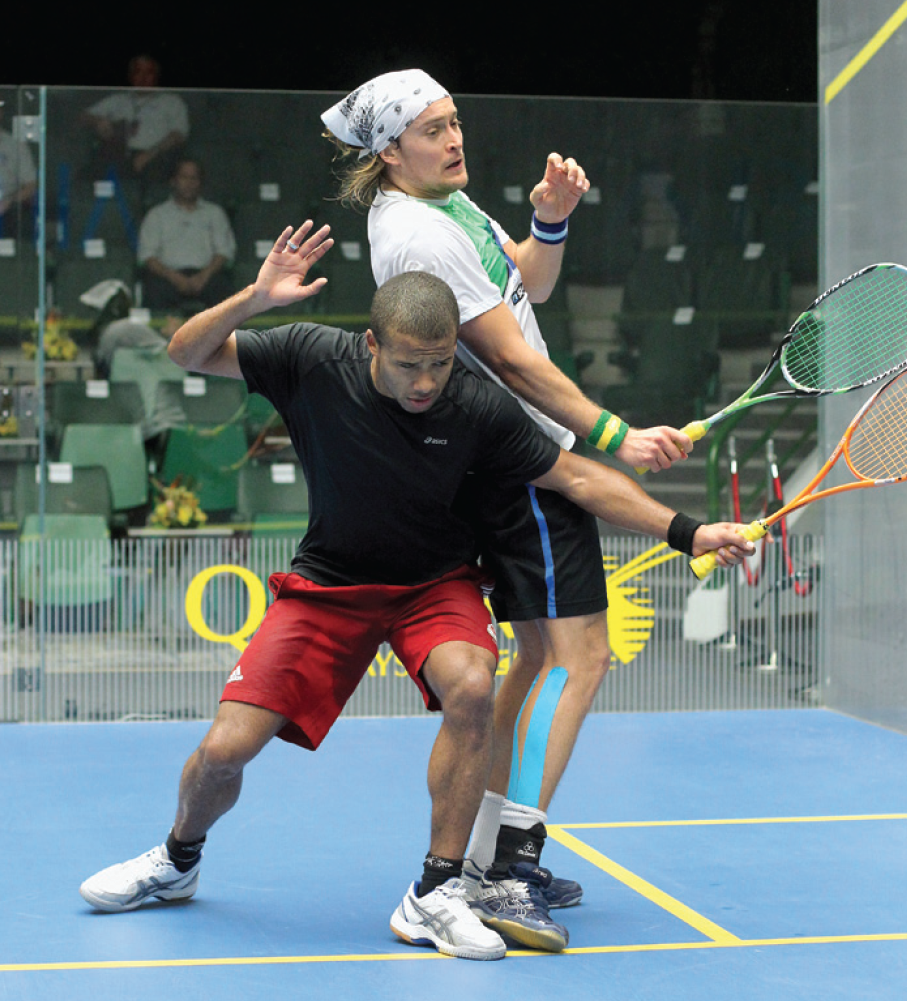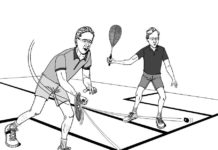By Barry Faguy, WSF Referees and Rules Committee
Well…in Squash, yes. And you won’t need a watch. Our subject here relates to the moment one of the players makes an appeal—and how you, as a referee, need to consider where everything is, was, and would be. Let’s look at just three of the related concepts.
The ball has no ears!
You’ve no doubt heard some people say that it doesn’t matter what happens to the ball after the call of ‘Let’—but that’s not so! Yes, an appeal does indeed stop the play, but that’s not necessarily the end of it. Sometimes you need to consider what happens to the ball after that appeal. We are referring to situations where it’s clear that, interference or not, the ball had a predestined outcome. A common example occurs when the striker encounters interference while trying to get to a ball headed for the right rear—but clearly would not have been able to intercept it before it reached the right rear. The striker calls ‘Let’—and the ball then goes on to die in the nick in the right rear. Yes, the striker would have, but for the interference, reached the right rear—but the ball was irretrievable. The verbal appeal stops player movement—but not the unalterable movement of the ball. The ball has no ears! It pays no attention to the appeal. So, unless it would have been intercepted, don’t disregard the ball’s ultimate destination just because the striker called ‘Let’.

Music to our ears
An important problem in Squash is that we allow both audible and non-audible appeals. Because timing is so important for decision-making, the audible appeal makes a referee’s life a bit easier; the other makes it a bit harder.
Audible appeal
The rules specify that this is the way appeals are supposed to be made (out loud!). These are the easiest to deal with. The player calls out ‘Let’ and you now know the moment and the place where play stops. You then simply (yeah, right!) consider the usual factors and make your decision. As a club player, you should take note of this advice and make your appeals audible so that everyone will understand your intentions. You’ll likely also be doing yourself a favor in terms of the decision.
Non-audible appeal
Unfortunately, all too often, no sound is heard. So, aware of this fact in real-life play (especially with pros), the rules-makers also included an allowance for silent appeals—often only with visual clues, sometimes not even that! The allowance states in part: “A Referee accepting any form of appeal other than the standard …”—meaning that a player can do just about anything to get the intent across. Commonly we see a raised finger, a look, or just simply a stop in play. The player figures that it’s obvious to you that an appeal is being made. Indeed, most of the time one is—but if you have any doubt, be sure to ask the player if he or she is appealing. There’s little more embarrassing, after you have just finished awarding a Let, or worse, a Stroke, than to have the player announce that no appeal was intended. You see, sometimes the player is just conceding the rally.
Also, by using the silent approach, some players are hoping that you will pick the most advantageous point for their benefit to make your decision. In the face of the uncertainty often associated with the lack of audible appeal, you cannot be faulted if you don’t agree on that ‘advantageous’ point, right?
In one ear …
Sometimes an appeal is immediate— sometimes not. It’s common to see a player continue after the point of interference. There are two categories here:
Playing through before asking
This is a no-no, meaning that you are not to grant a let to a player who accepts the interference, carries on, and then, often realizing the difficulty of the return, then appeals. The rules are quite specific and require the player to make the appeal as soon as the interference occurs. It’s easy to see that there would be lots of abuse if the rules didn’t state this.
However, don’t expect an immediate appeal in cases of backswing contact. The movement is often so rapid that contact occurs, the ball is hit, and then goes down—all before the striker can utter the word ‘Let’. The referee is often oblivious to what happened until it’s explained. Given the sensitivity of the swing (as dealt with in previous articles), no striker would accept any such interference—so you should pretty much always give the benefit of any doubt and not consider that the striker has played through the interference.
Playing through after asking
This scenario differs in the timing because the striker does indeed appeal at the time of the interference—but then keeps on going to reach, and often hits the ball. This is common practice, and perfectly OK as long as the opponent, who has now dropped their guard, isn’t endangered. The striker is simply trying to avoid a ‘No Let’ by showing the referee that the ball was reachable. Of course, this can be risky for the player, because, even though it’s clear that the ball was reachable, the referee might then consider that the interference was ‘minimal’ (that the player wasn’t significantly disadvantaged by the interference)—and still conclude with a No Let.
Lend me your ears
Enough with the ‘ear’ lines, already! There’s really a lot more to say on this subject—but it’ll have to be for another time.
Meanwhile, if you want information on just about any officiating topic, visit The Squash Official online (www.squash.ca/e/officiating/tso/) and click on the ‘library’ link to the left to find your subject.





